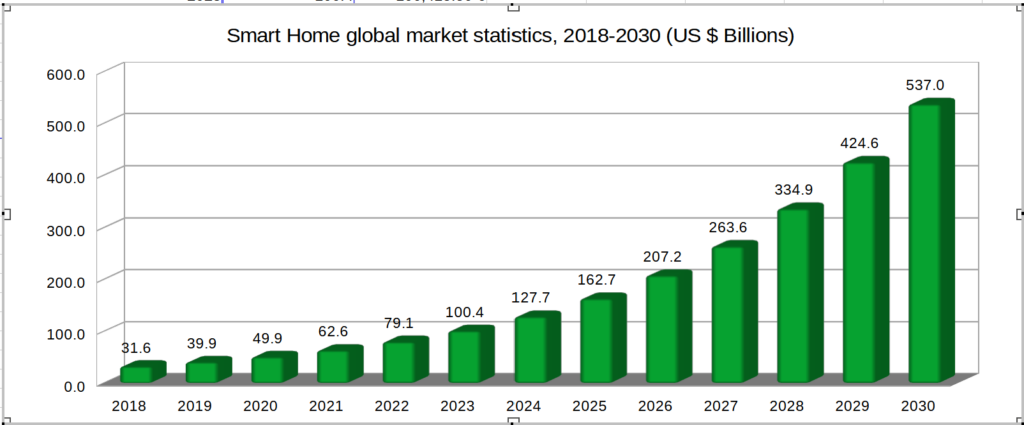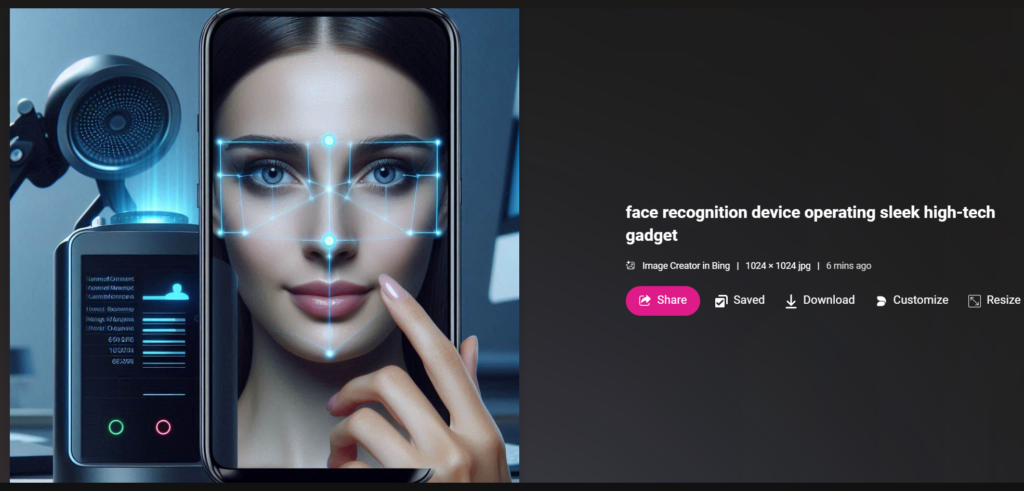
A smart home is defined as a residence equipped with internet-connected devices that enable remote management and automation of various household systems, including lighting, climate control, entertainment, and security. This sector’s rapid growth is driven by advancements in technology, increasing consumer awareness, and a growing emphasis on energy efficiency and sustainability. According to Statista, the global smart home market revenue is projected to reach $158 billion by 2024 (Statista).
Table of Contents
Smart Home Market Size & Trends
The global smart home market size was valued at USD 79.16 billion in 2022 and is expected to grow at a compound annual growth rate (CAGR) of 27.07% from 2023 to 2030. Smart home products are available in the form of cameras, smart lights, streaming devices, dishwashers, and more. The growing trend of integrating Artificial Intelligence (AI) in smart home products for smart features is expected to increase product demand. Moreover, the high penetration rate of smartphones and the internet globally is driving the demand for connected smart home products. Digital assistance integrated with AI is offering users a hands-free and more user-friendly deployment of smart devices, significantly impacting buyers’ preferences (GrandViewResearch).

Global Smart Home Market Highlights
The global smart home market generated revenue of USD 100,415.5 million in 2023 and is projected to reach USD 537,008.4 million by 2030. The market is anticipated to grow at a compound annual growth rate (CAGR) of 27.1% from 2024 to 2030.
Segment Overview
- Security & Access Controls: This segment accounted for revenue of USD 29,485.0 million in 2023.
- Home Healthcare: This segment emerged as the most lucrative, exhibiting the fastest growth during the forecast period.
Regional Insights
- North America: This region was the largest revenue-generating market in 2023.
- United States: The U.S. is expected to register the highest CAGR from 2024 to 2030.
Global Data Book Summary
- Market Revenue in 2023: USD 100,415.5 million
- Market Revenue in 2030: USD 537,008.4 million
- Growth Rate: 27.1% (CAGR from 2023 to 2030)
- Largest Segment: Security & Access Controls
- Fastest Growing Segment: Home Healthcare
- Historical Data Covered: 2018 – 2022
- Base Year for Estimation: 2023
- Forecast Period Covered: 2024 – 2030
- Quantitative Units: Revenue in USD million
Market Segmentation
- Security & Access Controls
- Lighting Control
- Entertainment Devices
- HVAC
- Smart Kitchen Appliances
- Home Appliances
- Smart Furniture
- Home Healthcare
- Other Devices

Current Market Dynamics
As of 2024, the smart home market is characterized by several key dynamics:
- Technological Advancements: Rapid advancements in AI, machine learning, and IoT technologies continue to drive innovation in the smart home sector. These technologies enable more intuitive and responsive devices, enhancing user experience. According to McKinsey, the IoT market is expected to grow to $1.6 trillion by 2025 (McKinsey).
- Consumer Demand: There is a growing consumer demand for smart home products, driven by the increasing awareness of their benefits. This demand is further fueled by the rising adoption of smart assistants and the proliferation of smart devices. Statista projects that the global smart home market will reach $75.44 billion in 2025 (Statista).
- Regulatory Environment: Governments worldwide are increasingly recognizing the potential of smart homes in achieving energy efficiency goals. As a result, there is a growing emphasis on creating supportive regulatory frameworks that encourage the adoption of smart home technologies. The European Union’s Energy Performance of Buildings Directive (EPBD) aims to promote smart building technologies to improve energy efficiency (EU Commission).
Key Trends and Innovations in Smart Homes
- Enhanced Security: Security remains a top priority in smart homes. In 2024, we can expect advanced facial recognition and motion-sensing technologies, enabling systems to distinguish between residents, visitors, and intruders, thereby enhancing security while maintaining privacy. Smart security systems, including cameras, motion detectors, and smart locks, provide enhanced security, giving homeowners peace of mind whether they are at home or away. A report by MarketsandMarkets estimates that the smart security market will reach $55.7 billion by 2023 (MarketsandMarkets).
- Green and Energy-Efficient Homes: Smart homes are going green. Future trends include energy-efficient appliances, smart thermostats, and solar-powered systems. These technologies not only reduce carbon footprints but also significantly lower utility costs. Smart home devices offer unparalleled convenience, allowing homeowners to manage their homes with ease. For instance, smart thermostats can learn a user’s schedule and preferences, optimizing heating and cooling to save energy and reduce costs. According to the U.S. Department of Energy, programmable thermostats can save homeowners up to 10% annually on heating and cooling (Energy.gov).
- Integration and Connectivity: The Internet of Things (IoT) is expanding, allowing for seamless integration and connectivity between devices. This means your fridge could communicate with your smartphone to notify you when you’re running low on groceries, or your oven could start preheating while you’re still on your way home. This past year, Sengled launched one of the industry’s first Matter-enabled smart light bulbs. Matter technology offers enhanced compatibility.
- Advanced Voice and Gesture Control: Voice assistants are becoming more sophisticated. In 2024, expect to see more intuitive voice control systems that understand natural language. Additionally, gesture control will start to become more prevalent, offering a new, more convenient way to interact with your smart home devices.
- Health Monitoring: Smart homes will play a crucial role in health monitoring. Wearables that sync with home systems can monitor vital signs and alert medical professionals in case of an emergency. Moreover, smart homes could track air quality, allergens, and other environmental factors, ensuring a healthier living environment.
- Enhanced Home Entertainment: Home entertainment is getting an upgrade. Virtual and augmented reality will become integral parts of the home entertainment experience, offering immersive gaming, movie watching, and interactive fitness sessions.
- Artificial Intelligence (AI): AI is set to revolutionize smart homes by offering more personalized experiences. AI systems will learn from your habits and preferences, automatically adjusting lighting, temperature, and even playing music based on your mood or the time of day.
- Autonomous Smart Appliances: Smart appliances will become more autonomous. Imagine a refrigerator that can order groceries or a laundry machine that selects the optimal wash cycle based on fabric type. Additionally, domestic robots for cleaning, cooking, or even pet care are expected to become more commonplace.
- Customizable Living Experiences: Smart homes will offer more than just technological advances; they will provide customizable living experiences. With modular designs and smart materials, residents can easily alter their living spaces to suit their changing needs or preferences.
- Integration with Smart Cities: Smart homes won’t exist in isolation. They’ll integrate with the broader infrastructure of smart cities, sharing data to improve traffic flow, energy use, and emergency response times, creating a more connected and efficient urban living experience.
Beyond Residential: Smart Homes in Industry and Office Spaces
The smart home market is not limited to residential spaces; it extends to industrial and office areas, commonly referred to as smart buildings or smart commercial buildings. These buildings utilize the same principles of connectivity and automation to enhance energy efficiency, security, and convenience in non-residential environments. According to a report by MarketsandMarkets, the smart building market is expected to grow from $60.7 billion in 2021 to $105.8 billion by 2026 (MarketsandMarkets).

Historical Emergence and Evolution
The concept of the smart home first emerged in the late 20th century, with early innovations focusing on home automation systems. However, it wasn’t until the advent of the Internet of Things (IoT) in the early 2000s that the idea began to gain traction. The IoT enabled a multitude of devices to be interconnected, paving the way for sophisticated home automation solutions. Over the years, the smart home market has evolved dramatically, with significant milestones including the introduction of smart assistants like Amazon’s Alexa and Google Home, which have further popularized the adoption of smart home technologies (TechCrunch).
Smart Homes and Green Policies
One of the most significant benefits of smart homes is their potential contribution to green policies and sustainability initiatives. Smart home devices can help reduce energy consumption, lower carbon footprints, and promote more sustainable living practices. Here are a few ways in which smart homes support green policies:
- Energy Efficiency: Smart thermostats and lighting systems can significantly reduce energy usage by optimizing operation based on occupancy and user preferences. This not only lowers utility bills but also reduces the overall demand on power grids. The American Council for an Energy-Efficient Economy (ACEEE) states that smart home devices can reduce energy consumption by 10-15% (ACEEE).
- Water Conservation: Smart irrigation systems and water management devices can help conserve water by ensuring it is used efficiently. These systems can adjust watering schedules based on weather conditions and soil moisture levels, reducing waste. According to the Environmental Protection Agency (EPA), smart irrigation systems can reduce water use by 15% (EPA).
- Waste Reduction: Smart appliances, such as refrigerators and washing machines, are designed to operate more efficiently, reducing waste and extending the lifespan of the devices. Additionally, smart home systems can provide insights into usage patterns, helping users make more informed decisions about consumption. The U.S. Department of Energy highlights that smart appliances can save up to 20% on energy use compared to standard models (Energy.gov).
- Renewable Integration: Smart homes can seamlessly integrate with renewable energy sources, such as solar panels and wind turbines. Home energy management systems can optimize the use of renewable energy, storing excess power for later use and reducing reliance on non-renewable sources. The National Renewable Energy Laboratory (NREL) emphasizes the role of smart home technologies in enhancing the efficiency and reliability of renewable energy systems (NREL).
Challenges in Data Privacy and Security
While the benefits of smart homes are substantial, there are notable challenges related to data privacy and security. The interconnected nature of smart devices means that they collect and transmit large amounts of data, which can be susceptible to breaches.
Government Measures to Enhance Data Safety in IoT
Governments can play a critical role in enhancing data privacy and security within the smart home market. Here are several measures they can take:
- Legislation and Regulation: Implementing robust data protection laws and regulations can help safeguard consumer data. The General Data Protection Regulation (GDPR) in the European Union is an example of comprehensive legislation aimed at protecting personal data (GDPR).
- Standardization: Establishing standards for data security in IoT devices can ensure that manufacturers adhere to best practices. The National Institute of Standards and Technology (NIST) provides guidelines for securing IoT devices (NIST).
- Public Awareness Campaigns: Governments can run awareness campaigns to educate consumers about the importance of data privacy and security, and how they can protect themselves.
- Collaboration with Industry: Governments can collaborate with industry stakeholders to develop and implement security protocols that protect consumer data. Partnerships between public and private sectors can lead to more secure IoT ecosystems.
- Research and Development: Investing in research and development for advanced security technologies can help address emerging threats. Governments can fund initiatives aimed at developing innovative solutions to enhance data privacy and security.

smart home market smart home market smart home market smart home market smart home market smart home market smart home market
Leave a Reply